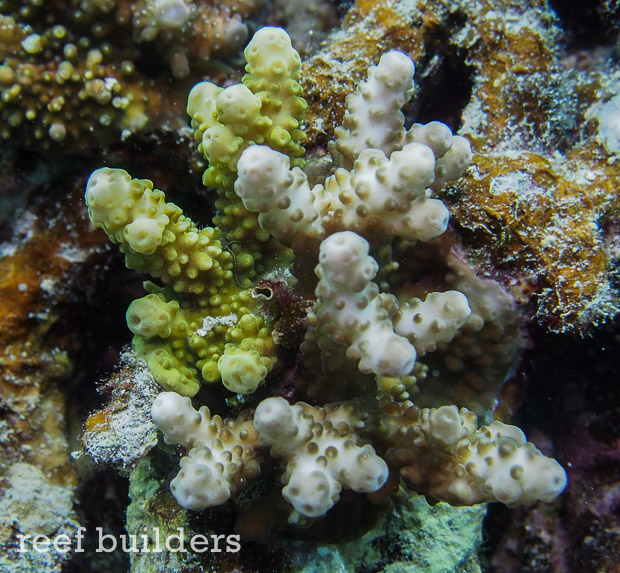During the Fluval Sea Flores Expedition we came across a couple of specimens of unusual, bicolored Acropora colonies. It’s always surprising to meet with a single coral harboring two very different color patterns throughout the colony. We don’t exactly know the correct explanation for this particularity.
Possibilities could be a Chimera; two larvae settling together on the same spot and fusing together, or if it is a tissues grafting; where a small tissue part of another colony of the same species but different color become trapped on the receiving colony, fuse together and start growing.
A genetic aberration is also a possibility, when color-expressing gene mutes and starts expressing a different color. But the most possible cause of this dual color is probably a pigment protein infection whether from another colony of the same species or from a totally different species, which is caught by a polyp, and start being produced by this same polyps, and all the other polyps grown from this single polyp, leading to a complete part of the colony being of a different color although all other pattern such as colony shape remain the same
 This would offer the corals the possibility to adapt much faster to a particular habitat, and different lighting conditions. By grabbing some released pigments from a neighboring and better adapted colony. During the expedition we came across at least two specimens that we documented. The first one we found was a perfect colony shape of Acropora brueggemanni that we found in the shallow part of a turbid and relatively protected reef. It was sitting in the middle of a huge A. brueggemanni dull colored stand, in 15 feet of water.
This would offer the corals the possibility to adapt much faster to a particular habitat, and different lighting conditions. By grabbing some released pigments from a neighboring and better adapted colony. During the expedition we came across at least two specimens that we documented. The first one we found was a perfect colony shape of Acropora brueggemanni that we found in the shallow part of a turbid and relatively protected reef. It was sitting in the middle of a huge A. brueggemanni dull colored stand, in 15 feet of water.
The second bicolored coral we came across was probably a form of Acropora florida, of a common green lime color, but after close examination we noticed a small purple branch growing on the side of it. On the macro shot we can clearly see that it started on the side of a very small branch with 2/3 of it being green and the other third shaded part of it growing purple. Then the next growing branch is completely purple but with the same green polyp color than on the rest of the colony. We found this coral on a clear water drop off, exposed to current in 50 feet of water. 



